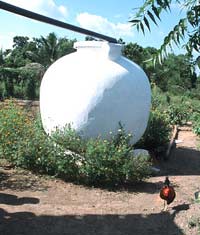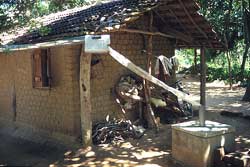Tiempo Climate Cyberlibrary
Rainwater Harvesting
 |
The Intermediate Technology Development Group
(ITDG) South Asia describes a rainwater harvesting
project, designed to help people adapt to climate
change in Sri Lanka and elsewhere.
|
|
ITDG is an international development agency
with the vision "a world free of poverty and
injustice in which technology is used to the benefit
of all." ITDG South Asia currently works in the
areas of energy, transport, manufacturing,
agro-processing, disaster mitigation and natural
resource management.
|
The Intermediate Technology Development Group (ITDG)
South Asia began its rainwater harvesting pilot
demonstration projects with financial assistance from the
European Community and the Department of Agriculture in Sri
Lanka. Support from the Fulmer Trust also allowed ITDG to
strengthen its Livelihood
Options for Disaster Risk Reduction (LODRR) Project by
including work on rainwater harvesting. The LODRR project
began in 2001 with assistance from the
Conflict and Humanitarian Affairs Department of the
Department for International Development in the United
Kingdom. The LODRR project took a regional approach to the
issue of disaster risk reduction. But at the individual
country level, emphasis on implementing project components
such as research, pilot demonstrations, capacity building
and advocacy varied, depending on country needs.
Work on rainwater harvesting began in the Moneragala
District of Sri Lanka.
Pilot demonstration projects were then established in
Usgala Village of Sooriyawewa Divisional Secretariat
Division in Hambantota District, and in Mahameddawa Village
in Nawagaththegama Divisional Secretariat Division in
Puttalam District. All community participants were from
economically marginalized sections of society. They had
been subject to four or five seasons of crop failure
resulting from bad climatic conditions. Drought was
increasing in their areas. The unavailability of good
quality water for drinking and other domestic purposes
meant that diseases such as diarrhoea were common amongst
community members.
The concept of rainwater harvesting
In Sri Lanka, drought occurs as a result of monsoon
failure or reduced precipitation. Two thirds of Sri Lanka
is categorized as a dry zone, and is prone to long dry
spells and frequent droughts. Some parts of Sri Lanka's
dry zone receive only 1000 to 1250 mm of rainfall per year.
Most people in this area rely on irrigated paddy
cultivation and subsistence farming, and drought affects
the livelihoods of these people. An inability to store
enough rainwater for use in the dry months means that many
farmers have to survive with just one annual crop cycle.
Water security is eroded and some villagers find themselves
having to travel almost ten kilometres in search of potable
water. Production decreases and incomes decline during
drought periods. Project areas in other countries are also
dry. For example, intervention areas in Pakistan have less
than 400 mm of rainfall per year.
|

|
Above-ground
rainwater harvesting tank
© ITDG South Asia
|
Rainwater harvesting is not a new idea for Sri Lankans -
they have used the concept since ancient times. But modern
rainwater harvesting technologies needed a 'testing
time'. This was mainly due to technical deficiencies
and a lack of awareness about the operation and maintenance
of rainwater harvesting tanks. Focus was placed on
developing technologies to suit the local conditions and on
creating awareness among village level practitioners about
best operational and maintenance practices. As a result of
continuous effort to develop appropriate technologies, and
with assistance from various government and non-government
institutions, ITDG and its partner organizations were able
to develop appropriate rainwater harvesting techniques.
In the past, many organizations built and promoted the
use of underground tanks to harvest rainwater. But the
proliferation of plant roots damaged the tanks making
maintenance expensive. Promotion of the above-ground Ferro
cement domestic rainwater harvesting tanks used by the ITDG
projects successfully solved this problem. Many other
institutions have promoted above-ground rainwater
harvesting structures, but due to various deficiencies in
their planning, construction and maintenance, most
communities considered them less successful.
As evidence of this success, the initiatives taken by
Care International and World Vision (as well
as many other local non-government organizations) using
ITDG pilot demonstration projects for their educational
programmes can be cited. The National Disaster Management
Center also implemented a special programme to provide
tiles for all villagers with roofs thatched with cadjan
leaves in Usgala Village, so that villagers could practice
rainwater harvesting. The second Water and Sanitation
Project of Puttalam District also constructed 100 rainwater
harvesting tanks for the villagers of Mahameddawa. This
provided all village households with rainwater harvesting
tanks for use in their own houses. This initiative was a
direct result of information sharing and advocacy
activities carried out by the ITDG project with the help of
the relevant authorities.
Livelihood improvements
A rainwater harvesting tank with a capacity of 5000
litres allows people to harvest a minimum of 25,000 litres
of water in a normal year. Households in Mahameddawa
Village used this water for eight months during the drought
period. Without this water, villagers could have suffered
severe hardship, especially in a drought year like 2001
when they might have had to have walked two or three
kilometres to fetch water. Ms Jayasingha of Mahameddawa
Village stated that "thanks to rainwater harvesting
tanks, now we can live with peace of mind. Even though we
may not have anything to eat due to the drought, we know
that we have at least good quality water at our doorstep to
drink."
|

|
Rainwater
harvesting
© ITDG South Asia
|
With improvements introduced by ITDG, Sri Lanka now
promotes the construction of aboveground Ferro cement tanks
with a capacity of 7500 litres. Rainwater harvesting is
also used to support village livelihood options based on
agriculture. Simple drip irrigation systems are fitted to
above-ground rainwater harvesting tanks. The pressure
created from the water in the tank is all that is needed
for irrigation - pumps and other mechanical devices used
for drip irrigation elsewhere are not necessary. Drip
irrigation supports the growth of crops for which there is
a high market demand. Another simpler type of drip
irrigation system - the bucket kit method - is also used to
cultivate high value crops.
'Run off rainwater harvesting' is mainly used
for agricultural purposes. This method collects free
flowing groundwater in tanks with a capacity of 5000 to
12,000 litres. Some 30 to 35 perennial crops can then be
grown in half an acre of land. To maximize the efficient
use of available water, 'pitcher (pot) irrigation'
is used coupled with mulching and other best agricultural
practices. A 7500 litre aboveground domestic water tank
costs around 20,000 Rupees (about US$200). A run off
agricultural rainwater harvesting tank with a capacity of
10,000 litres will cost around 12,000 to 15,000 Rupees
(US$120 to US$150), depending on whether or not
construction materials are available locally. In all
instances, the community contributed around 45 to 50 per
cent of the costs. ITDG and its partner organizations
always emphasize the importance of community contributions,
as this gives a sense of ownership to the project
participants.
The approach
The technology itself is a package comprising
'hardware' and 'software'. The
'hardware' includes the technology and the physical
project components. The 'software' includes
community mobilization, participatory development of the
technology itself, and capacity building for the use of the
technologies. The contribution and participation of
communities is an important component of project
sustainability. Giving training on the technology to the
local masons and providing knowledge on the operation and
maintenance of the technology to other community members
enhances the quality of the water they will receive.
Large-scale replication
Replication of the project by other agencies started
before the project was completed. Replication of the total
approach and its various components was done by government
agencies in Sri Lanka and Pakistan, international donors
such as the Disaster Preparedness Programme of the European
Commission Humanitarian Office - South Asia, and
international non-governmental organizations such as the
United Nations
Development Programme,
OXFAM Pakistan,
Plan International Sri Lanka, and Care International
Sri Lanka.
Further information
Rohana Weragoda, ITDG South Asia, No. 5 Lionel Edirisinghe
Mawatha, Kirulapone, Colombo 5, Sri Lanka. Fax: +94 11 2
856188. Email: rohanaw@itdg.slt.lk. Web:
www.itdg.org.
On the Web
The Tiempo Climate Cyberlibrary presents a listing of
websites covering rainwater
harvesting.


